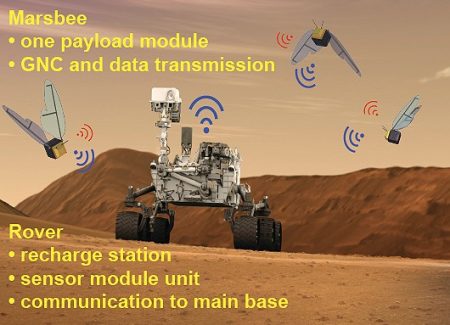April 1, 2018 – For botanists looking at the future colonization of the Moon and Mars, a major challenge to plant reproduction remains. Unless the plants we end up growing in these non-Earth environments find non-sexual ways to reproduce while retaining the advantages of variation derived from sexual reproduction, colonists will face the dangers that come from dependency on monoculture crops.
On Earth bees and other insects play a critical role in the spread of pollen vital to plant propagation. But how can we bring bees to Mars or the Moon? We can create closed self-sustaining greenhouse environments for raising plants. But we can’t easily reproduce the gravity of Earth that essentially provides the counterweight to insect-winged flight.
NASA is looking at Marsbees but not for plant propagation, but rather for exploring the outdoor environment of Mars. Marsbees won’t be a genetically modified bumblebee. They will be robots about the size of Earth’s bumblebees but with much larger wingspans to be able to fly in the thin Martian atmosphere.
One of 25 of the latest NASA-funded NIAC Awards for 2018 is entitled Marsbee. Proposed by the team lead, Chang-kwon Kang, at the University of Alabama in Huntsville, this joint effort combining U.S. and Japanese researchers is working on the invention of a micro-flapping winged robot designed to fly in low-density atmospheres. What Marsbees will look like is a cross between an Earth bumblebee and a cicada. The body size will be similar to the former. The wing size will be akin to the latter. Each Marsbee will contain an integrated package of sensors and wireless communication. A mobile base will act as a recharging station and communication relay. The Marsbees will be sent out in swarms to explore the Red Planet sending back data to the base station on Mars.
The challenge isn’t in the Marsbee body but in designing wings that are insect-like but able to have sufficient aerodynamic properties to work in the thin Martian atmosphere. If the wings are designed right then the power requirements of the Marsbees will be negligible. Design considerations include a torsional spring at the wing root to store wasted energy allowing the Marsbee to flap just like an Earth bumblebee.
The first phase of the newly-funded project will determine wing design, optimal weight, and aerodynamic performance. Testing will be done in a vacuum chamber containing air density equivalent to that found on Mars. The researchers should be able to test various designs to see which is most capable of maneuvering, dealing with takeoff and landing, and other flight dynamics.
Proof of concept will then lead to further funding by NASA of the onboard instrumentation that will make up the body of each Marsbee.
Of course, the Marsbee envisioned in this project will be of no use in solving the challenge of propagating plants on Mars or the Moon for that matter through sexual reproduction as it occurs here on Earth. These are not bees that can fly from flower to flower. For that scientists will have to come up with an invention that is far different. Since plants in these low-atmosphere to no-atmosphere, and low-gravity environments, will need closed life support facilities, it may be possible to import genetically modified symbiotic insect partners to help. It is either that or the creation of nanorobot equivalents to insect helpers to make off-Earth agriculture work.
Is there an alternative to insect-assisted sexual reproduction that can help us establish robust plant life to support humans in space? Can we genetically alter plants here on Earth that use sexual reproduction to become regenerative without insect helpers?
There is no doubt humans will not survive off-Earth without plants. They are essential for life support, for food, oxygen, the removal of carbon dioxide, and for water recycling. So we need another type of Marsbee other than the one for which NASA just provided funding. Previously I wrote about Eijiro Miyako, a Japanese chemist whose work at the National Institute of Advanced Industrial Science and Technology led to the development of a tiny drone insect equivalent. Will a robotic device like this Miyako bee fly around the greenhouse environments of future Mars settlements?








